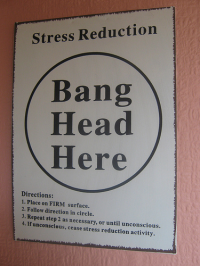Fit Rec at 5pm any given afternoon is a zoo of the sweaty and the stressed. Boston University students under pressure flock to the gym to avoid the freshman (or sophomore, or junior, or senior) fifteen. Others dine on Sargent Choice options and walk Comm Ave to class in lieu of taking the bus.
All of these efforts to maintain physical health are fine and dandy, but an apple a day and a little cardio isn’t the only path to total well-being. There’s also that big mass of gray goop sitting in our skulls – that thing that helps us take tests and remember to go to class. Too often college students neglect their mental health. This can be at great costs.
The second leading cause of death in college students isn’t something medical. It’s not car accidents; in fact, it’s no accident at all. The second leading cause of death in college students is suicide. More often than not, suicide is entirely preventable; depression and anxiety are treatable conditions.

College is a period of transition and self-discovery, and so it’s also a time for emotional and mental difficulty. Dr. David Shim, full-time lecturer in Psychology at BU and practicing psychologist who worked for four years in college counseling, describes the perfect storm of changes. “College students have the same kinds of experiences with mental health issues as the general populace,” Shim says. “The only big difference is that it is focused around school which not only includes academic pressures but also issues related to being away from home, living and being more responsible for themselves, loss of previous relationships, pressure to form new ones, et cetera.”
Shim adds that students can then run into anxiety, depression and substance abuse.
College kids are accustomed to feeling at least some level of stress at all times, and with classes, work, clubs, and a future to plan, stress is to be expected. But at what point does that stress surpass a “normal” level and become a threat to our mental health?
Dr. Shim described a helpful scale system for determining whether or not this stress is controllable or out of control. “Using a scale of 1 to 10, with 1 being least amount of stress and 10 being the most, after 6 or 7, they should think about ways to reduce their anxiety in healthy ways. When it is an 8, 9 or 10, time for help,” he said.
Many students identify their own need for intervention but avoid receiving help, allowing their mental health problems to generate unwarranted embarrassment and shame. Anxiety and depression are not shameful; they’re common. BU recognizes this, and has instituted a number of services for students in the throws of these afflictions. Student Health’s Behavioral Medicine department is located at 881 Commonwealth Ave and is contactable by phone. In more urgent situations, behavioral medicine staff is even available to speak over the phone twenty-four hours a day.
Beyond this, there’s the BU-affiliated Danielsen Institute located at 185 Bay State Road. The mental health clinic offers therapy and other services and will even integrate religious principles at the client’s request. For students with anxiety, the BU Center for Anxiety and Related Disorders located in Kenmore Square is a research facility that offers treatment as help with its ongoing studies in anxiety. If a patient qualifies, the fees are minimal and close to free; no one is turned away because of financial hardship.
Despite these abundant available resources, the stigma surrounding mental health troubles is enough to push some students deeper into holes of social isolation and self-defeatism. Active Minds is a student-run organization with the goal of reducing this stigma and educating students on how common mental health difficulties really are. A University of Pennsylvania student, Alison Malmon, created the organization in 2001 after losing her brother to suicide. She realized there was a need for an open dialogue about mental illness in college communities. Today there are over 350 chapters of Active Minds, one being Boston University’s.
According Ashley Waters, BU chapter president, “It is important to have an organization like Active Minds at BU because… we understand the everyday problems that can stress other students out. We want to create a safe environment for people to express themselves and provide resources to get help if necessary.”

Active Minds participates in the National Day Without Stigma and a number of other events and projects throughout the school year. This spring, Active Minds will host its annual BU Secret. BU Secret takes inspiration from the popular cultural phenomenon and book series Post Secret by asking students to submit creatively designed postcards with their deepest or perhaps most troubling secrets written on them. The “secrets” are compiled and displayed on several bulletin boards throughout campus. “BU Secret is meant to raise awareness about mental health,” Waters said. “While we get funny secrets, we also get many secrets that deal with issues such as suicide and mental health. We want this event to show students that even if they feel alone at a school as big as BU if they are facing a problem.”
When the going gets tough, running away from problems never has to be the answer. The resources available at BU have been implemented for a reason. Life isn’t always a cakewalk down Comm Ave, and being proactive about the health of that grey goop can mean the difference between a secure future beyond college or a rocky start in the real world.
Getting involved with Active Minds isn’t a great time commitment, but can have a sizable impact on the BU community. The club meets every other Monday evening and more often for project or event involvement. Interested students can contact activemindsbu@gmail.com.

Research indicates that half of all lifetime cases of mental illness begin by age 14, well before adulthood. Three new studies investigate the cognitive, genetic and environmental factors that may contribute to mental health disorders in adolescence. The studies are published in Psychological Science and Clinical Psychological Science, journals of the Association for Psychological Science. ..
Our favorite web site
<,http://www.healthmedicinecentral.com/shingles-without-rash/